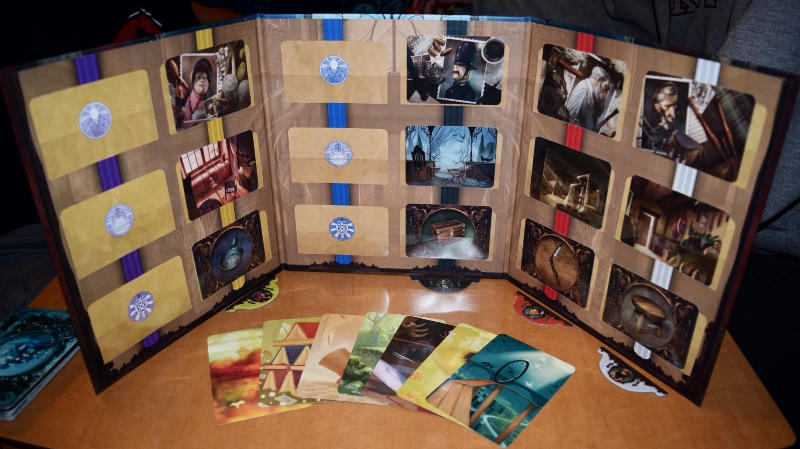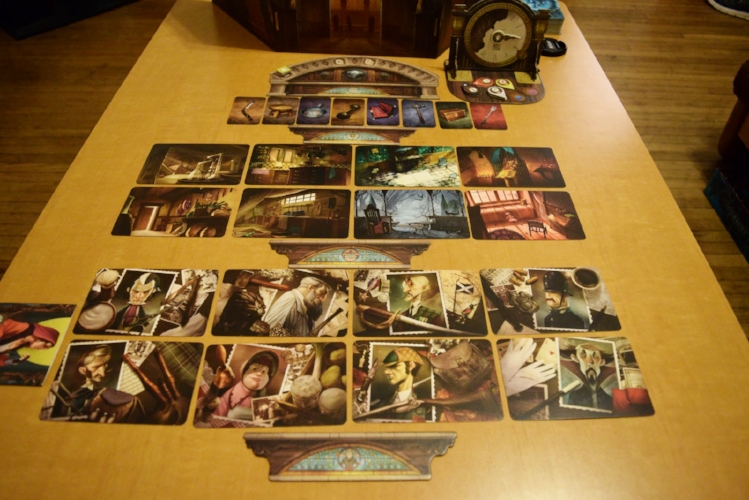We, as a society, are excited by the chance to solve a good murder mystery. Unearthing a fatal incident long passed in hopes of recovering a story lost to time. Gathering data, testing hypothesis, scrutinizing every little detail; we love the hunt. And when a piece of the puzzle falls into place, how satisfying it is knowing you’ve come to that conclusion through sheer cunning and wit.
Mysterium looks to capitalize on this feeling and make a narrative for players to embark on every time they crack open the box.
Set in 1920’s Scotland, Mysterium is an asymmetric co-op experience, one of the first of its kind. A seemingly complex description, what this actually means is everyone is working together, but at least one player will have abilities unique to them.
Each game, one individual will take on the role of the ghost, a sort of spectral Dungeon Master. Determined to not be forgotten, the ghost gives the other players clues each round so that they can puzzle out who the ghost is and how they died before time runs out and the ghost fades away.
Before you assume this is just Clue with a slight twist, it’s worth noting that the Ghost player must help reveal this information in silence. Using beautifully illustrated cards featuring abstract art, the ghost is trying to guide each player to identify specific cards featuring people, places, and things. While there may be up to eight suspects to choose from (depending on the number of players), the investigators must suss out who is supposed to get which.
Each round, the Ghost picks one or more vision cards from their hand to give to each investigator. These cards, featuring wild and often ominous dreamscapes, will hopefully bear some symbolic clue as to which suspect, location, and murder weapon each investigator needs to identify.While all investigators are allowed to deliberate over which option is correct, ultimately it’s the player who received the clues who must commit to an answer, placing their chunky crystal ball token on the appropriate card.
Additionally, players may vote on whether their friends are right or wrong, earning clairvoyance points if they guess correctly. While not immediately helpful, clairvoyance will allow players to receive more clues in the final and most crucial round of the game.
After all investigators have placed their crystal balls, the Ghost informs them who chose right and wrong. If the guess was correct, that player places that card in front of them, moving their crystal forward so they are guessing within a new category during the next round. If wrong, that player continues in the current category, armed with more information.
If all investigators manage to collect their suspect, weapon, and location cards within seven turns, a final round begins. The Ghost provides a final set of clues based on the clairvoyance earned during the game. The investigators must correctly identify which player’s suspect, location, and weapon tell the story of the ghost’s murder. If the majority of investigators vote for the correct set of cards, the mystery is solved and everyone wins!
… Which immediately leads to the Ghost, after a sigh of relief, exploding in a continuous stream of exclamations, explanations, and general noises of gleeful frustration. For investigators and the Ghost alike, the main source of fun and humor in this game is having a player who knows all but cannot explicitly help anyone with that knowledge, forcefully limited in their means of communication. It’s funny as the Ghost visually struggles with being unable to speak as everyone debates over the meanings of their cards and attempt to deduce the roundabout logic of providing them with such obscure clues.
I can recall one scenario when, after having received three vision cards, I sat contemplating the various details and smaller images hidden in the background of each, trying to find some string of logic amidst the mess of ideas. As I looked up at the Ghost, I noticed him shaking behind his player shield. Whether it was from laughter or frustration, I couldn’t tell, but it was hilarious to the rest of us regardless.
Unfortunately, this just as easily leads to scenarios in which the Ghost can be blamed for everything that goes wrong in the game. Mysterium relies on the Ghost player to set not just the tone, but the pace of the game. On one end, they must provide interesting yet readable clues, and be able to get into the heads of the other players without speaking a word. On the other, they need to do this in a reasonable amount of time.
The first time I played Mysterium, someone who I barely knew took on the role of the Ghost. As we investigators sat perusing the various images spread on the table, the Ghost struggled to come up with even a single clue from his first hand of cards, taking three or four minutes to begin taking their turn. Simply put, the Ghost role is a difficult one, and the wrong player taking on that job can easily ruin a session. I for one swore off the game for nearly a year before returning to it with a group of friends I knew fairly well.
There are a couple of easy ways to prevent this from happening, the easiest of which is to make sure that whoever becomes the Ghost has played the game before. Having a Ghost who can basically run the game at an even pace while also having the knowledge to recognize what clues are useful will allow players to grow comfortable and invested in the idea of the game, potentially giving them the confidence to try the role in a future game.
For the game to run smoothly, the ghost needs to be comfortable making due with what they have and willing to risk handing out imperfect visions. A few games have been hampered by those who second-guess themselves constantly, berating themselves for giving bad clues, and ultimately giving up well before the game has even ended, growing deeply embarrassed. At times, it can feel like there are no good options in their hand of cards, perpetuating this feeling of negativity that ultimately affects the whole table. Some players will never feel like they’re ready to attempt this job, and that’s okay; recognizing this is the most important part of making it a fun experience for everyone.
A flaw that I’ve found in repeated plays of Mysterium is the limited pool of cards provided. There are only 18 of each of the suspect, location, and murder weapon cards, meaning that after three or four games, you’ll have seen every card hit the table in some way. This can lead to a feeling of monotony; at one point, I realized we had seen the same couple of person cards two or three games in a row. When I went to replace them, I was shocked by how we had already seen everything the box had to offer.
This also extends to the vision cards, leading to its own set of issues. The Ghost can end up stuck with a hand of useless cards, forcing them to provide clues that are sometimes useless or downright impossible. It’s frustrating to feel like you can do nothing but give a random card to someone, knowing that they will almost assuredly guess incorrectly. For me, this creates a feeling of false difficulty; there are cards in the deck that I know would be perfect as clues in this situation, but because I didn’t happen to draw into them, it doesn’t matter. It feels like, in this manner, Mysterium works hard to build a puzzle not through its cleverness but through creating situations that obscure the solutions. Yes, I do recognize that being able to choose whatever cards I wanted each time would make the game way too easy, but it still made me feel like I was forced to play sub optimally, deflating the overall experience.
On top of this, repeated plays will result in certain clues become synonymous with specific suspects, locations, and weapons. I’ve found myself holding desperately onto a card dotted with candles until a later round when I can give that clue to the person who needs to get, you guessed it, a candle. The more times you play this game, the easier it will become.
There are some solutions to this; an expansion pack, Hidden Signs as well as a plethora of promotional cards exist to pad out the card counts for vision cards and suspect/location/weapon cards alike. Still not satisfied? Some creative gamers have begun using cards from the game Dixit in place of the vision cards, which feature similar if not more bizarre dreamscapes. While effective, these are expensive solutions and result in Mysterium becoming a multi-box affair, adding to an already lengthy setup time.
It’s worth noting that, while the game claims to support two to seven players, Mysterium shouldn’t be played with less than four. In the lower player counts, each investigator is forced to try and deduce two different sets of cards. This combined with the fact that there are fewer differing opinions to lead to the aforementioned moments of humor turns the game into a rather bland slog.
For all the potential, Mysterium lacks the concrete structure and variety that I needed, ultimately a game with great aesthetics but lackluster mechanics, like a withered ghost in its own right.
Luke Muench is a freelance writer and the founder & host of the youtube series Budget Board Gamer.





